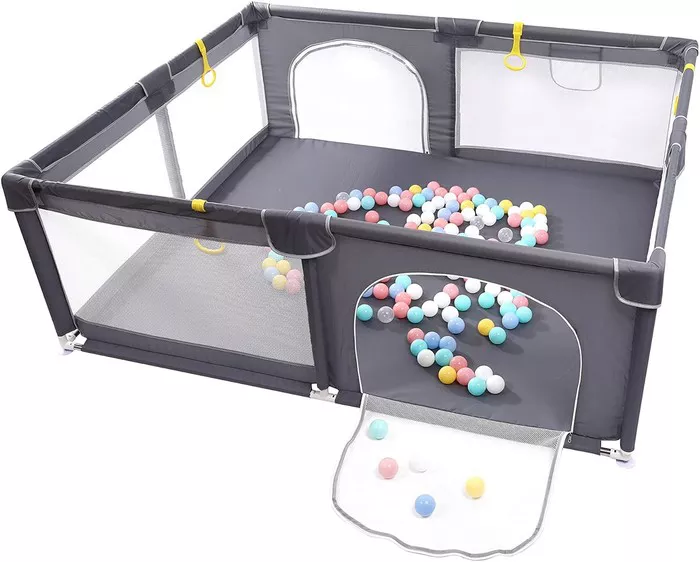Playards, often referred to as Pack ‘n Plays or travel cribs, have become an indispensable piece of baby gear for modern parents. These portable cribs offer a convenient solution for providing a safe space for infants and toddlers to play, nap, and sleep. However, as with any sleep environment for babies, there are important safety considerations to take into account when using playards for sleep. In this comprehensive guide, we delve into the safety aspects of playards, addressing concerns and providing guidelines to ensure the safest sleep environment for your little one.
Understanding Playards:
Playards are designed to be versatile and portable, making them ideal for use at home, while traveling, or visiting friends and family. They typically consist of a collapsible frame made of metal or plastic, surrounded by mesh or fabric panels. The compact design allows for easy transportation and storage, making playards a popular choice for parents on the go. Most playards come with a mattress pad that fits snugly inside the frame, providing a comfortable sleeping surface for babies.
Safety Considerations:
1. Sturdy Construction: One of the primary safety considerations when using a playard for sleep is the construction quality. Look for playards with sturdy frames and secure locking mechanisms to prevent accidental collapses or entrapment hazards. Check for any sharp edges or protruding parts that could pose a risk to your baby.
2. Breathable Materials: The materials used in the construction of playards play a crucial role in ensuring safety, particularly concerning airflow. Choose playards with breathable mesh sides to promote air circulation and reduce the risk of suffocation if a baby’s face presses against the side during sleep.
3. Mattress Firmness: The mattress pad provided with the playard should be firm and fit snugly within the frame. A firm mattress helps to prevent the baby from sinking into soft bedding, reducing the risk of suffocation or positional asphyxia. Avoid using additional mattress toppers or pads that may compromise the firmness of the sleeping surface.
4. Proper Assembly: Follow manufacturer instructions carefully when setting up the playard to ensure it is assembled correctly. Improper assembly can create gaps or instability, posing potential safety hazards for sleeping infants. Check that all locking mechanisms are engaged and that the playard is securely in place before placing your baby inside.
5. Age and Weight Limits: Adhere to the manufacturer’s recommended age and weight limits for the playard. Using a playard beyond these limits can compromise safety and increase the risk of accidents or injuries. As your baby grows, transition to a larger sleep environment that meets their developmental needs.
Guidelines for Safe Sleep in Playards:
1. Back to Sleep: Always place babies on their backs to sleep, whether in a playard, crib, or bassinet. This sleeping position reduces the risk of Sudden Infant Death Syndrome (SIDS) and promotes optimal airflow. Avoid placing soft bedding or toys in the playard that could obstruct the baby’s airway.
2. Use a Firm Mattress: Ensure the playard mattress is firm and fits snugly within the frame without any gaps around the edges. Soft bedding, such as pillows or plush mattress toppers, should be avoided to prevent suffocation hazards. The mattress should be covered with a fitted sheet that is tightly secured to prevent it from coming loose during sleep.
3. Remove Loose Bedding: Keep the sleep environment in the playard free from loose bedding, including blankets, pillows, and stuffed toys. These items can pose suffocation risks or increase the likelihood of overheating. Instead, dress your baby in lightweight clothing appropriate for the ambient room temperature.
4. Monitor Temperature: Maintain a comfortable room temperature for the baby to prevent overheating. Use lightweight, breathable fabrics for bedding and clothing, and avoid overdressing your baby. Keep the playard away from direct sources of heat, such as radiators or heaters, to prevent the risk of burns or overheating.
5. Supervision is Key: While playards are designed to provide a safe sleep environment, it’s essential to supervise infants and toddlers during sleep. Regularly check on your baby to ensure they are sleeping safely and comfortably. Be vigilant for any signs of discomfort or distress and adjust the sleep environment as needed to ensure your baby’s well-being.
6. Avoid Elevated Surfaces: Never place a playard on an elevated surface, such as a table or countertop, as this increases the risk of falls or tip-overs. Always set up the playard on a stable, flat surface away from potential hazards. Keep cords, curtains, and other objects that could pose entanglement hazards away from the playard.
7. Check for Recalls: Periodically check for recalls or safety updates related to your playard model. Stay informed about any potential hazards or issues identified by the manufacturer or regulatory agencies. If your playard is subject to a recall, follow the manufacturer’s instructions for remediation or replacement to ensure continued safety for your baby.
Conclusion:
Playards offer a convenient and versatile solution for providing a safe sleep environment for babies and toddlers. By following safety guidelines and best practices, parents can ensure that their little ones sleep soundly and safely in their playards. From selecting a well-constructed playard to creating a conducive sleep environment and monitoring your baby’s sleep, prioritizing safety is paramount. With proper care and attention to safety considerations, playards can be a trusted sleep solution for families on the go.


